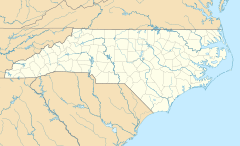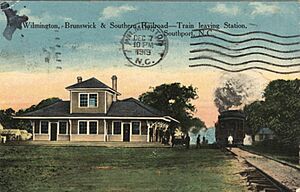Southport, North Carolina facts for kids
Quick facts for kids
Southport, North Carolina
|
|||
|---|---|---|---|

South Howe Street
|
|||
|
|||
| Motto(s):
"The Home of Salubrious Breezes"
|
|||
| Country | United States | ||
| State | North Carolina | ||
| County | Brunswick | ||
| Established | 1792 | ||
| Area | |||
| • Total | 4.04 sq mi (10.47 km2) | ||
| • Land | 4.00 sq mi (10.37 km2) | ||
| • Water | 0.04 sq mi (0.09 km2) | ||
| Elevation | 20 ft (6 m) | ||
| Population
(2020)
|
|||
| • Total | 3,971 | ||
| • Density | 991.76/sq mi (382.89/km2) | ||
| Time zone | UTC−5 (Eastern Time Zone (North America)) | ||
| • Summer (DST) | UTC−4 (EDT) | ||
| ZIP code |
28461
|
||
| Area codes | 910, 472 | ||
| FIPS code | 37-63400 | ||
| GNIS feature ID | 2405498 | ||
Southport is a cool city located in Brunswick County, North Carolina, right by where the Cape Fear River meets the ocean. In 2020, about 3,971 people lived there. The city's leader, Mayor Rich Alt, was chosen in November 2023 for a two-year term. Southport is also famous for its big Fourth of July Festival, which brings in 40,000 to 50,000 visitors every year!
Contents
History of Southport
Early Exploration and Fort Building
Spanish explorers first visited the Southport area in the 1500s. Later, in the 1700s, British settlements along the Carolina coast needed protection. They were often attacked by pirates and privateers from Spain. To stop these attacks, Governor Gabriel Johnston decided in 1744 that a fort was needed. This fort would defend the important Cape Fear River area.
The best spot for the fort was found at the mouth of the river. Around the same time, France declared war on Britain (this was called King George's War). This made the fort even more necessary. Spanish privateers were also getting bolder. So, in April 1745, North Carolina's government approved building "Johnston's Fort," which became known as Fort Johnston. South Carolina helped by lending ten small cannons. In 1748, money was set aside for building, and construction finally began. The town of Southport grew up around this fort.
From Smithville to Southport
Southport was first started as the town of Smithville in 1792. Joshua Potts wanted a town next to Fort Johnston. The North Carolina General Assembly then created a group of five men to help set up the new town. It was named after Benjamin Smith, who was a colonel during the Revolutionary War and later became a governor of North Carolina.
Smithville began as a fishing village and also supported military activities. It was the main town for Brunswick County from 1808 to 1977. To try and make the town a bigger shipping port, Smithville was renamed Southport in 1887. Even today, the area where Southport is located, called Smithville Township, and other places like the cemetery, still use the old Smithville name.
Railroad Connections
After changing the name to Southport, people hoped to connect it by train to Wilmington. This would link Southport to larger train systems like the Atlantic Coast Line and Seaboard Air Line Railroad. After many years of trying, the Wilmington, Brunswick and Southern Railroad finally started running in 1911.
This train line went northwest from Southport to Bolivia. Then, it turned northeast towards Navassa, where it connected to the existing train network. The railroad was not built very well and often ran out of money. It also faced strong competition from cars and trucks. Because of these problems, the 30-mile-long railroad stopped operating in 1945.
Ten years later, the U.S. Government built a new train line. This line connected the Military Ocean Terminal Sunny Point, just north of Southport, to the main train system. It took a different, more direct route. So, even though renaming the town to Southport didn't make it a huge shipping port, it became known for its relaxed feeling and charming old-fashioned seaside look.
Geography and Climate
Southport's Location
Southport is located in the southeastern part of Brunswick County. It sits on the northwest bank of the Cape Fear River, about 2 miles (3.2 km) from the Atlantic Ocean. North Carolina Highway 211 comes into the city from the north as North Howe Street. It goes south almost to the waterfront, then turns east onto East Moore Street. This road leads northeast out of the city and then east again as Ferry Road. Ferry Road takes you to the ferry that crosses the Cape Fear River to Fort Fisher.
The city covers a total area of about 4.04 square miles (10.47 square kilometers). Most of this area, about 4.00 square miles (10.37 square kilometers), is land. Only a small part, about 0.04 square miles (0.09 square kilometers), is water.
Weather in Southport
Southport has a humid subtropical climate (Cfa). This means summers are very hot and humid. Winters are quite mild compared to other parts of North Carolina. Southport is actually the warmest place in North Carolina! Its average yearly temperature is 65.0°F (18.3°C). This is more like the weather you'd find in coastal Georgia or northern Florida.
| Climate data for Southport 5 N, North Carolina (1991–2020 normals, extremes 1892–2016) | |||||||||||||
|---|---|---|---|---|---|---|---|---|---|---|---|---|---|
| Month | Jan | Feb | Mar | Apr | May | Jun | Jul | Aug | Sep | Oct | Nov | Dec | Year |
| Record high °F (°C) | 82 (28) |
81 (27) |
90 (32) |
94 (34) |
97 (36) |
103 (39) |
102 (39) |
102 (39) |
101 (38) |
94 (34) |
88 (31) |
81 (27) |
103 (39) |
| Mean maximum °F (°C) | 71.7 (22.1) |
74.6 (23.7) |
78.8 (26.0) |
84.3 (29.1) |
89.1 (31.7) |
94.3 (34.6) |
96.2 (35.7) |
95.2 (35.1) |
90.8 (32.7) |
86.1 (30.1) |
81.1 (27.3) |
74.2 (23.4) |
98.1 (36.7) |
| Mean daily maximum °F (°C) | 60.0 (15.6) |
62.5 (16.9) |
68.2 (20.1) |
75.8 (24.3) |
82.5 (28.1) |
88.4 (31.3) |
91.6 (33.1) |
90.4 (32.4) |
86.5 (30.3) |
78.9 (26.1) |
69.9 (21.1) |
62.9 (17.2) |
76.5 (24.7) |
| Daily mean °F (°C) | 47.8 (8.8) |
50.1 (10.1) |
55.5 (13.1) |
63.3 (17.4) |
71.2 (21.8) |
78.7 (25.9) |
82.2 (27.9) |
80.8 (27.1) |
76.3 (24.6) |
66.6 (19.2) |
57.1 (13.9) |
50.5 (10.3) |
65.0 (18.3) |
| Mean daily minimum °F (°C) | 35.5 (1.9) |
37.6 (3.1) |
42.7 (5.9) |
50.9 (10.5) |
60.0 (15.6) |
69.0 (20.6) |
72.8 (22.7) |
71.2 (21.8) |
66.0 (18.9) |
54.4 (12.4) |
44.3 (6.8) |
38.0 (3.3) |
53.5 (11.9) |
| Mean minimum °F (°C) | 16.0 (−8.9) |
19.9 (−6.7) |
25.7 (−3.5) |
33.3 (0.7) |
43.8 (6.6) |
54.8 (12.7) |
62.7 (17.1) |
60.7 (15.9) |
51.9 (11.1) |
36.3 (2.4) |
27.7 (−2.4) |
18.2 (−7.7) |
12.2 (−11.0) |
| Record low °F (°C) | 0 (−18) |
1 (−17) |
8 (−13) |
25 (−4) |
36 (2) |
45 (7) |
46 (8) |
53 (12) |
35 (2) |
23 (−5) |
16 (−9) |
−3 (−19) |
−3 (−19) |
| Average precipitation inches (mm) | 3.70 (94) |
3.32 (84) |
4.03 (102) |
3.08 (78) |
3.44 (87) |
4.02 (102) |
5.55 (141) |
6.77 (172) |
8.16 (207) |
5.41 (137) |
3.42 (87) |
3.74 (95) |
54.64 (1,388) |
| Average precipitation days (≥ 0.01 in) | 8.2 | 8.7 | 8.0 | 6.0 | 7.7 | 9.0 | 10.0 | 11.0 | 9.8 | 7.1 | 7.4 | 8.6 | 101.5 |
| Source: NOAA (mean maxima/minima 1981–2010) | |||||||||||||
People of Southport
Population Changes Over Time
| Historical population | |||
|---|---|---|---|
| Census | Pop. | %± | |
| 1870 | 810 | — | |
| 1880 | 1,008 | 24.4% | |
| 1890 | 1,207 | 19.7% | |
| 1900 | 1,336 | 10.7% | |
| 1910 | 1,484 | 11.1% | |
| 1920 | 1,664 | 12.1% | |
| 1930 | 1,760 | 5.8% | |
| 1940 | 1,760 | 0.0% | |
| 1950 | 1,748 | −0.7% | |
| 1960 | 2,034 | 16.4% | |
| 1970 | 2,220 | 9.1% | |
| 1980 | 2,824 | 27.2% | |
| 1990 | 2,369 | −16.1% | |
| 2000 | 2,351 | −0.8% | |
| 2010 | 2,833 | 20.5% | |
| 2020 | 3,971 | 40.2% | |
| U.S. Decennial Census | |||
The number of people living in Southport has changed quite a bit over the years. In 1870, there were 810 residents. By 2020, the population had grown to 3,971 people.
Who Lives in Southport?
| Race | Number | Percentage |
|---|---|---|
| White (non-Hispanic) | 3,422 | 86.17% |
| Black or African American (non-Hispanic) | 286 | 7.2% |
| Native American | 16 | 0.4% |
| Asian | 24 | 0.6% |
| Pacific Islander | 1 | 0.03% |
| Other/Mixed | 116 | 2.92% |
| Hispanic or Latino | 106 | 2.67% |
According to the 2020 United States census, there were 3,971 people living in Southport. These people made up 1,434 households, and 942 of those were families. Most of the residents are White, with smaller numbers of Black or African American, Native American, Asian, and other groups.
Economy and Local Business
Brunswick Nuclear Power Plant
Near Southport, there's a large power plant called the Brunswick Nuclear Generating Station. It was built in the 1970s and has two nuclear reactors. This plant is operated by Duke Energy Carolinas. It's located about 5 miles (8 km) from the Atlantic Ocean.
After a nuclear event in Japan, the Brunswick plant added temporary flood barriers. These barriers help keep the doors watertight. This was done to protect the plant from flooding, especially during big storms like Hurricane Florence. The barriers can stop flooding from a storm surge up to 26 feet (7.9 m) high. Before Hurricane Florence hit in 2018, Duke Energy safely shut down both reactors at the plant.
Southport in Media
Local News and Radio
The city has its own newspaper called The State Port Pilot. You can also listen to local radio stations like WAZO (107.5 FM) and WJSL-LP (100.7 FM), which are licensed to Southport.
Filming Location
Southport is a popular spot for filming TV shows and movies!
- TV series filmed here include Revenge and Under the Dome.
- Many movies have also been made in Southport, such as:
- I Know What You Did Last Summer
- Summer Catch
- Domestic Disturbance
- Crimes of the Heart
- Mary and Martha
- Nights in Rodanthe
- A Walk to Remember
- Safe Haven
- More recently, the movie Greedy People was filmed in Southport between May and June 2022.
Fun Facts About Southport
- Did you know that Southport shares its name with another town? There's also a Southport in the United Kingdom, and it was founded in the same year, 1792!
See also
 In Spanish: Southport (Carolina del Norte) para niños
In Spanish: Southport (Carolina del Norte) para niños





